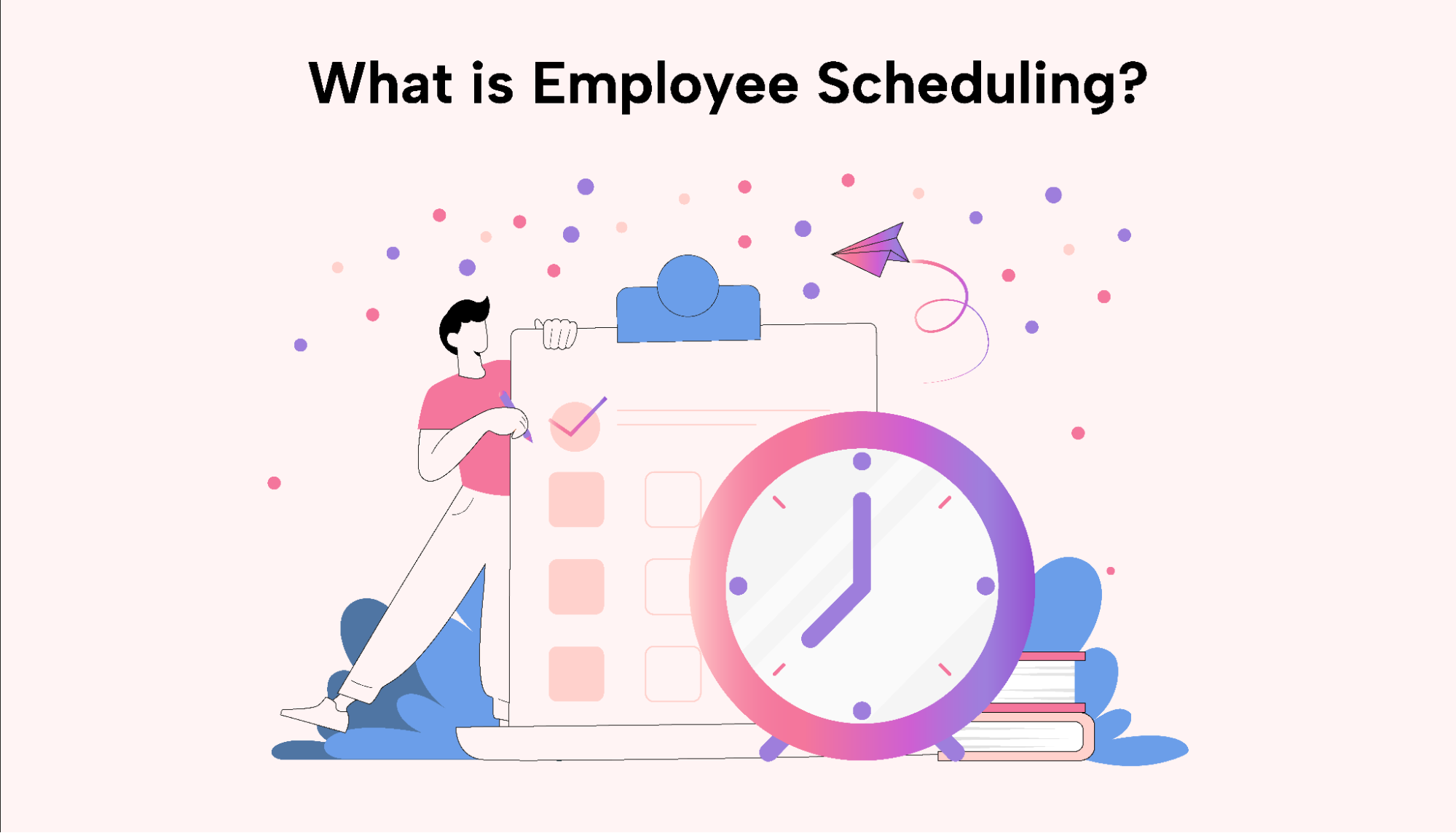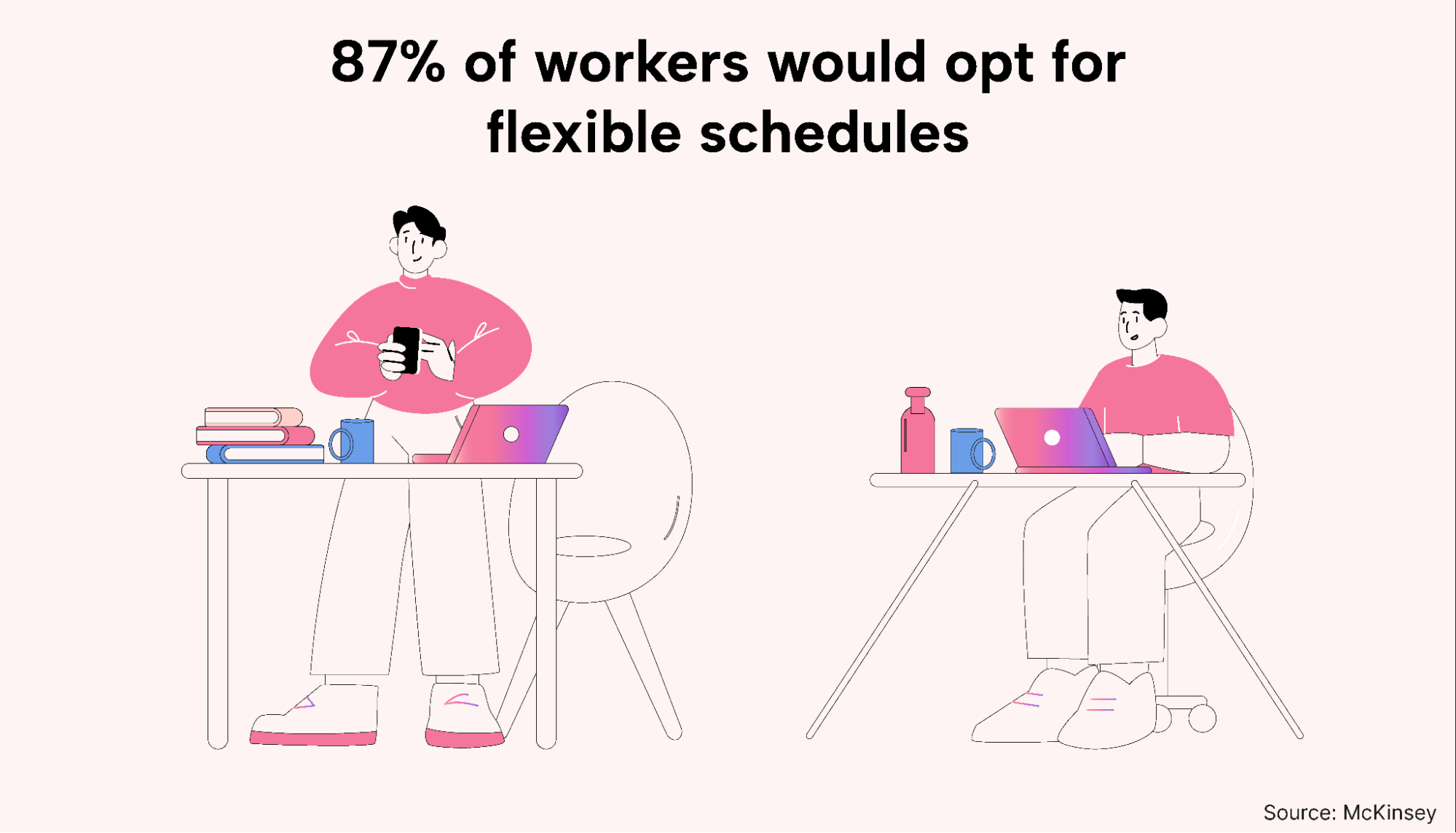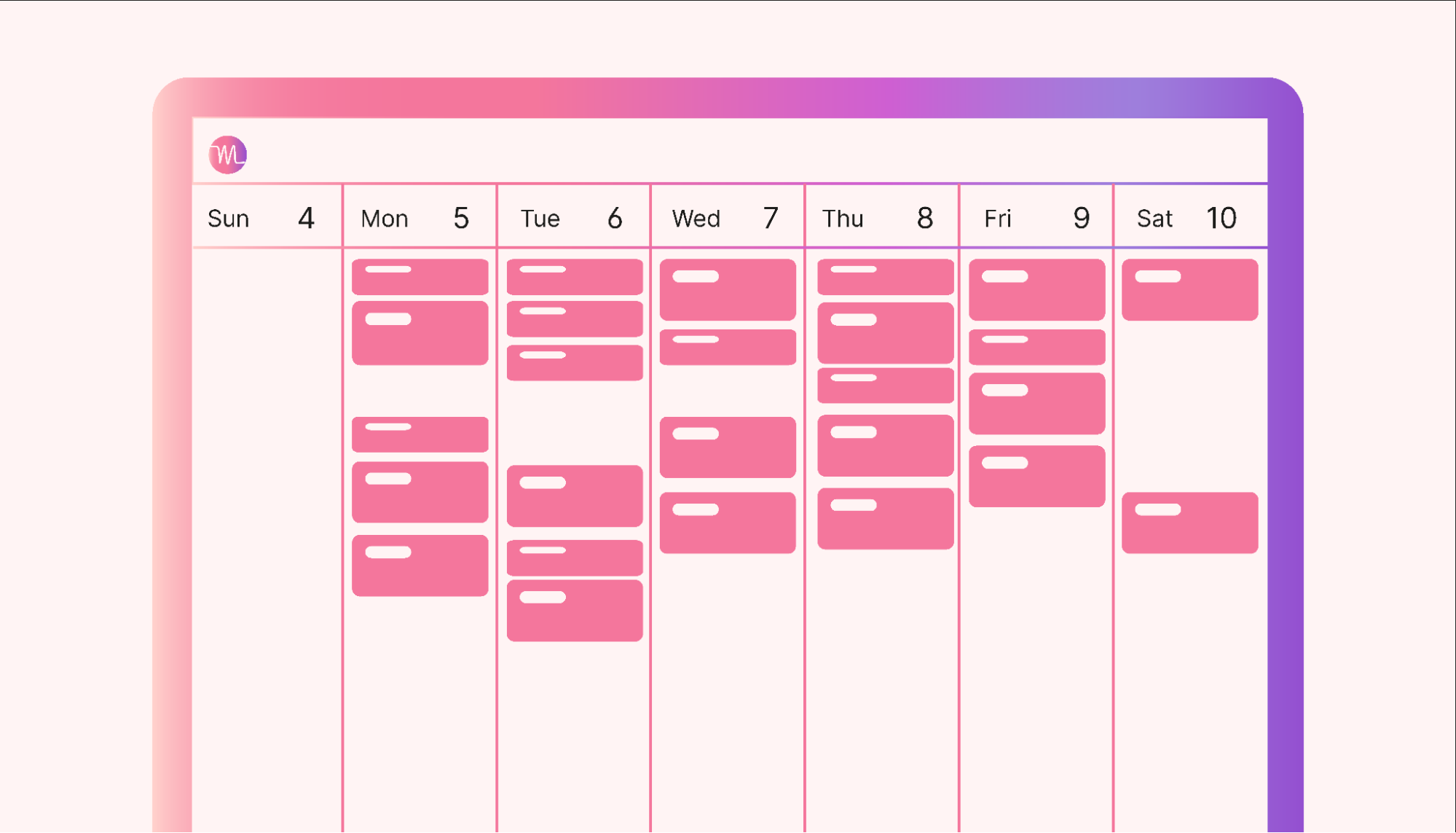Crafting the perfect employee schedule takes time, effort, and energy. You need to balance your business needs with your employees’ needs, which is no easy feat.
However, the proper knowledge and tools can make this process more manageable.
Read on to learn how to start creating employee schedules faster — mastering this critical area of team management once and for all.
What is employee scheduling?
Employee scheduling is the process of organizing the time your employees are on the job.
 |
Your schedule outlines which days per week your employees will work and the times you expect them to be there. Schedules are drafted with consideration of each employee’s employment contract, job responsibilities, and local labor laws.
Employee work schedules must be established in a way that also meets the organization’s needs. That means managers with scheduling responsibilities should be able to determine how many employees are required for projects and tasks, anticipate future workloads, and adapt to any changes in real time.
While finding this balance can be a challenge, there are some definite benefits to establishing a solid employee schedule.
What are the benefits of a consistent employee schedule?
A consistent employee schedule saves managers time, energy, and effort in the long run.
Whether you use a reusable template or employee scheduling software, you’ll find that your efforts are no longer spent recreating the wheel when you have a framework in place. Instead, you’ll have a go-to system that allows you to spend your valuable time on your other responsibilities.
And your employees will thank you for it, too, since most want to know their schedule ahead of time. In fact, 75% of workers want stable and predictable schedules they can count on. Knowing their workdays and hours allows them time to plan their work tasks and manage their responsibilities.
A consistent daily schedule also demonstrates respect for employees’ home lives. Employees and managers who are on the same page about when the former are expected to work means reduced frustration for both parties.
Employees also like to have some say in their schedules. Be transparent about the company’s needs and ask for employee feedback. Employees who have some buy-in and receive clear communication are more engaged in the workplace.
 |
And this pays off — companies with engaged employees are 23% more profitable than those without.
Now that you know more about why employee schedules are essential, let’s discuss the different types so that you can choose the one that best fits your business needs.
Different types of employee schedules
The types of schedules your employees have, whether full-time, part-time, or something else entirely, affect their overall wages and benefits.
Here’s a breakdown of the different employee schedules:
- Full-time work is defined by the U.S. Bureau of Labor Statistics as 35 hours per week or more. However, this is not a mandate, as many businesses consider a minimum of 40 hours per week full-time. A full-time schedule may include any combination of days of the week.
 |
- Part-time work is anything less than the full-time requirement established by the business or organization.
- A standard schedule is a set of regular days and hours. It doesn’t include weekends or evenings. The most common standard work schedule goes from Monday to Friday, from 9 a.m. to 5 p.m.
- A fixed schedule means employees can expect to work the same days and times from week to week. If a fixed schedule changes, the employee is typically given advance notice.
- A flexible schedule outlines a certain number of hours the employee is expected to work per week, but they have input into when and how those hours are worked.
For example, an employee may work from 9 to 5 on Monday and Tuesday and 10 to 6 for the rest of the week. In some workplaces, employees’ schedules may shift from week to week, depending on work and home demands.
 |
Flexible schedule options are gaining traction in the U.S. workforce. About 87% of workers would opt for a flexible schedule if offered the chance by their employer.
- Shift schedules typically occur when businesses run for more than eight hours and need employees rotating in and out of positions. A 24-hour shift schedule is commonly divided into morning, afternoon, swing, and night shifts.
Hospitals, transportation systems, factories, and hotels use employee shift schedules.
- A split schedule occurs when the employee’s workday is split into two sections, with at least two hours of unpaid free time between them.
This type of schedule is beneficial for businesses with peak and low times. For example, a restaurant may employ workers during lunch and then close for a few hours before the dinner rush. School bus drivers also work split schedules.
- Seasonal schedules are created for specific times in the year when the business needs more workers. These schedules can be any combination of the above. They might run from a few weeks to six months in length.
- Alternate schedules are anything that falls outside the norm for the company.
An alternate schedule could be a permanent or a temporary solution. For example, an employee may work remotely for a few months if they are helping care for a loved one with a health condition. An employee who moves out of state may also remain in a remote position with the company for the long term.
- Overtime schedules recognize employees who work beyond the typical 35 to 40-hour workweek. These typically go to hourly workers rather than salaried and are managed separately due to their effect on wages and benefits.
Depending on your business, you may find a range of employee schedules that suit you. Once you’ve narrowed down your needs, you’ll be ready to create your own.
How to create an employee schedule
Creating an employee schedule comes down to four steps. You need to take a look at your staff and your business needs, decide on a preferred scheduling format, and test it out.
Let’s delve into each of these a bit more.
1. Look at your staff
Start by looking at employee availability.
 |
The schedule you’re currently using will show who is working which days and which hours. If you discover gaps in it, find out if any staff members are available for those time slots.
Determine your employees’ preferences for their schedules, too. If you can accommodate their wishes, then do it. You’ll find that their ability to have a say in their schedule increases their engagement and productivity.
Also, make sure that each employee’s schedule matches their skill set. For example, would an individual benefit from a mentorship session a few times a week? If so, ensure that their schedule aligns with that of a potential mentor.
Employees with seniority, experience, or expertise in their roles and responsibilities might prefer work times with more flexibility.
Once you have a handle on your current staff availability, look ahead. What schedules might need to be covered based on employee leave requests? Are there expected growth areas in the company that might need additional workers at other times?
2. Determine your business’s needs
Each business has different needs based on its mission, goals, and products or services. Your own needs will help drive the types of schedules you create for your employees.
If your business is open 24 hours a day, for instance, you will need to establish shifts. Not only that, but the schedule should also accommodate transition times. Outgoing workers will have information that needs to be communicated to staff members on upcoming shifts. For example, a day shift hotel manager might schedule repairs for when the swing shift manager is on duty. If so, they’ll need to communicate that to them.
If your business is open for fixed hours, determine how many workers you need and why. You might find that a mix of schedules rather than a set, fixed schedule for every employee maximizes employee productivity.
Alternatively, you may find a hybrid work schedule offers your employees optimal benefits.
Every business has unique considerations for its workers. Determine your most critical needs and schedule staff accordingly.
Some companies may find they rely on workers to put in overtime. Decide how that will look for your employees to stay compliant with local labor laws.
If your business needs seasonal workers, determine those schedules ahead of time. Put a plan into place before you start recruiting.
3. Decide on your format
Various formats exist for employee schedules. It’s up to you to find the one that works best for your operations.
 |
- Microsoft Excel provides users with pre-made templates and auto-fill features. This may be a simple option if you’re already familiar with Excel.
However, it does take time to learn the program, and you’ll need to ensure all employees have easy access to it in order to share their schedules with them.
- Google Docs is another scheduling option. You can choose from pre-stored templates, but it will take some time to learn the program.
Your employees will need Google Drive to access their schedule.
- Scheduling software is becoming increasingly popular. It allows managers to set employee schedules, make changes, and alert employees through a convenient app.
Employing a modern scheduling tool provides you and your employees with significant benefits. Smart schedulers consider the various meetings, tasks, deadlines, and projects you may be managing.
Small business owners will also find that using a scheduling tool keeps team members on the same page regarding their assignments’ progress.
You can increase team collaboration and alignment even more with a weekly schedule template.
As you decide on a template, make sure it delivers on the following features:
- Managers and employees should be able to access the schedule easily from anywhere and at any time.
- Decide who will create and organize the schedule. Decide in advance how changes will be made and how staff will be notified.
- Ensure your schedule remains in compliance with all labor and employment laws.
- Make the schedule as easy to follow as possible. The last thing you need is a complicated scheduling process that requires a lot of management and upkeep.
4. Roll it out
Introduce the schedule to your employees. If it’s drastically different from what they’re accustomed to, you may want to offer a quick training session to get them up to speed. Ensure your employees have the opportunity to ask questions or get help solving any problems they encounter.
Ask your employees for feedback, too. What’s working well? What needs to be improved? Are employees able to access the schedule easily? Are they notified of changes in a timely manner?
Review their questions, comments, and concerns. Revise the schedule based on their feedback.
You’ll also want to review the process from your lens. Is your employee schedule more efficient than it was before? Has it saved you energy, effort, and time? If not, use the data you’ve gathered to make any necessary changes.
5. Don’t stop there
While establishing solid employee schedules is the first step, you’ll also want to examine individual staff schedules to get everyone on the same page. An app like Motion does the work for you, optimizing your schedule based on your priorities and deadlines.
Small business owners will benefit from adding project management features to the schedule. As Motion assigns tasks within a typical employee schedule, it keeps team members informed of assignments, progress, and completion so everyone knows what’s going on, and no one has to waste time searching for info.
Motion also integrates with other apps, including Google Calendar and Microsoft Teams, making it easier than ever to schedule and prioritize your team’s time.
Motion helps you draft schedules with ease
Creating employee schedules saves you time and effort, helping you build consistency and maintain compliance over time and increasing employee satisfaction and engagement.
Make the process hassle-free with Motion.
Once you have your employee schedules down, get everyone on the same page with Motion’s Project Management feature. With it, you can build a customized work schedule for each of your team members, including prioritizations and workload estimates. With most of your planning automated, you can spend more of your precious time focusing on other aspects of your business.
Start your 7-day free trial with Motion today.





